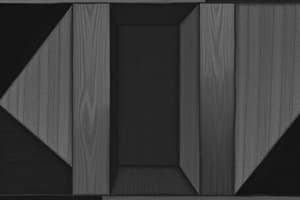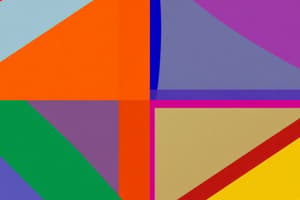Podcast
Questions and Answers
What is a parallelogram?
What is a parallelogram?
- A triangle with two equal sides
- A quadrilateral with both pairs of opposite sides parallel (correct)
- A rectangle with unequal sides
- A quadrilateral with no parallel sides
Which of the following is true for a parallelogram?
Which of the following is true for a parallelogram?
- Both pairs of opposite angles are congruent
- Adjacent angles are supplementary
- Both pairs of opposite sides are congruent
- All of the above (correct)
Name special types of parallelograms.
Name special types of parallelograms.
Rectangle, rhombus, and square
What defines a rectangle?
What defines a rectangle?
What is a rhombus?
What is a rhombus?
What is the definition of a square?
What is the definition of a square?
When is a parallelogram considered a rectangle?
When is a parallelogram considered a rectangle?
A parallelogram is always a rectangle if its diagonals are congruent.
A parallelogram is always a rectangle if its diagonals are congruent.
Which property can be used to prove a parallelogram is a rhombus?
Which property can be used to prove a parallelogram is a rhombus?
What proves that parallelogram ABCD is a rhombus?
What proves that parallelogram ABCD is a rhombus?
What type of quadrilateral is defined by having diagonals that do not bisect each other?
What type of quadrilateral is defined by having diagonals that do not bisect each other?
Which quadrilateral has diagonals that are always perpendicular bisectors of each other?
Which quadrilateral has diagonals that are always perpendicular bisectors of each other?
Which quadrilateral has diagonals that are always congruent?
Which quadrilateral has diagonals that are always congruent?
All rectangles are squares.
All rectangles are squares.
Flashcards
Parallelogram
Parallelogram
A quadrilateral with both pairs of opposite sides parallel.
Properties of Parallelogram
Properties of Parallelogram
All pairs of opposite sides and angles are equal.
Types of Parallelograms
Types of Parallelograms
Includes rectangle, rhombus, and square.
Rectangle
Rectangle
Signup and view all the flashcards
Rhombus
Rhombus
Signup and view all the flashcards
Square
Square
Signup and view all the flashcards
Congruent Diagonals
Congruent Diagonals
Signup and view all the flashcards
Rhombus Property
Rhombus Property
Signup and view all the flashcards
Proving Rhombus
Proving Rhombus
Signup and view all the flashcards
Isosceles Trapezoid
Isosceles Trapezoid
Signup and view all the flashcards
Square Diagonals
Square Diagonals
Signup and view all the flashcards
Congruent Diagonal Quadrilaterals
Congruent Diagonal Quadrilaterals
Signup and view all the flashcards
All Rectangles Are Squares
All Rectangles Are Squares
Signup and view all the flashcards
Study Notes
Parallelograms Overview
- Parallelograms are quadrilaterals with both pairs of opposite sides parallel.
Properties of Parallelograms
- Opposite angles are congruent.
- Adjacent angles are supplementary (sum to 180 degrees).
- Opposite sides are congruent.
- Diagonals bisect each other.
Special Types of Parallelograms
- Types include rectangles, rhombuses, and squares.
Rectangle Characteristics
- A rectangle is a parallelogram with at least one right angle.
- Diagonals in a rectangle are congruent.
Rhombus Characteristics
- A rhombus has four congruent sides.
- The diagonals are perpendicular to each other and bisect the angles.
Square Characteristics
- A square has four congruent sides and four right angles.
- Diagonals in a square are congruent and perpendicular.
Quadrilateral Attributes
- All quadrilaterals have four sides.
- A quadrilateral with one pair of parallel and congruent sides is a parallelogram.
Special Conditions for Parallelograms
- A parallelogram with congruent diagonals is a rectangle.
- A parallelogram is a rhombus if its diagonals are perpendicular.
Diagonal Intersection Properties
- In parallelogram ABCD, if diagonals AC and BD intersect, having diagonals that are not congruent indicates it's not a rhombus.
- If diagonals bisect opposite angles, quadrilateral ABCD may be a rhombus.
Isosceles Trapezoid
- A quadrilateral with diagonals that are congruent but do not bisect each other is termed an isosceles trapezoid.
Key Findings
- A rhombus does not necessarily have congruent diagonals.
- If a quadrilateral has diagonals that bisect its angles but aren't congruent, it's classified as a rhombus.
- A square is the only quadrilateral with diagonals that are always perpendicular bisectors of each other.
False Statements
- The claim that all rectangles are squares is false.
Studying That Suits You
Use AI to generate personalized quizzes and flashcards to suit your learning preferences.




